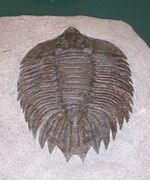Ludlow epoch
Topic: Earth
 From HandWiki - Reading time: 3 min
From HandWiki - Reading time: 3 min
Short description: 3rd series of the Silurian
| Ludlow | |
|---|---|
| 427.4 ± 0.5 – 423.0 ± 2.3 Ma | |
| Chronology | |
| Etymology | |
| Name formality | Formal |
| Name ratified | 1980[4] |
| Usage information | |
| Celestial body | Earth |
| Regional usage | Global (ICS) |
| Time scale(s) used | ICS Time Scale |
| Definition | |
| Chronological unit | Epoch |
| Stratigraphic unit | Series |
| Time span formality | Formal |
| Lower boundary definition | FAD of the Graptolite Saetograptus (Colonograptus) varians |
| Lower boundary GSSP | Pitch Coppice, Ludlow, United Kingdom [ ⚑ ] 52°21′33″N 2°46′38″W / 52.3592°N 2.7772°W |
| GSSP ratified | 1980[4] |
| Upper boundary definition | FAD of the Graptolite Monograptus parultimus. |
| Upper boundary GSSP | Požáry Section, Řeporyje District, Prague, Czechia [ ⚑ ] 50°01′40″N 14°19′30″E / 50.0277°N 14.3249°E |
| GSSP ratified | 1984[5][6] |
In the geological timescale, the Ludlow epoch (from 427.4 ± 0.5 million years ago to 423.0 ± 2.3 million years ago) occurred during the Silurian period, after the end of the Homerian age. It is named for the town of Ludlow in Shropshire, England .
The Ludlow epoch is subdivided into two stages: Gorstian and Ludfordian.
Paleontology
Arthropods
| Arthropods of the Ludlow | ||||
|---|---|---|---|---|
| Taxa | Presence | Location | Description | Images |
| Arctinurus | Wenlock epoch to Ludlow epoch | Europe and North America | Large (up to 30 centimetres (12 in)) trilobite | |
See also
References
- ↑ Jeppsson, L.; Calner, M. (2007). "The Silurian Mulde Event and a scenario for secundo—secundo events". Earth and Environmental Science Transactions of the Royal Society of Edinburgh 93 (02): 135–154. doi:10.1017/S0263593300000377.
- ↑ Munnecke, A.; Samtleben, C.; Bickert, T. (2003). "The Ireviken Event in the lower Silurian of Gotland, Sweden-relation to similar Palaeozoic and Proterozoic events". Palaeogeography, Palaeoclimatology, Palaeoecology 195 (1): 99–124. doi:10.1016/S0031-0182(03)00304-3.
- ↑ "Chart/Time Scale". International Commission on Stratigraphy. http://www.stratigraphy.org/index.php/ics-chart-timescale.
- ↑ 4.0 4.1 Holland, C. (1982). "The State of Silurian Stratigraphy". Episodes 1982 (3): 21–23. doi:10.18814/epiiugs/1982/v5i3/004. https://stratigraphy.org/gssps/files/sheinwoodian-ludfordian.pdf. Retrieved 11 December 2020.
- ↑ Lucas, Sepncer (6 November 2018). "The GSSP Method of Chronostratigraphy: A Critical Review". Frontiers in Earth Science 6: 191. doi:10.3389/feart.2018.00191. Bibcode: 2018FrEaS...6..191L.
- ↑ Holland, C. (June 1985). "Series and Stages of the Silurian System". Episodes 8 (2): 101–103. doi:10.18814/epiiugs/1985/v8i2/005. https://timescalefoundation.org/references/Silurian1.pdf. Retrieved 11 December 2020.
Licensed under CC BY-SA 3.0 | Source: https://handwiki.org/wiki/Earth:Ludlow_epoch6 views | Status: cached on October 01 2024 23:56:00↧ Download this article as ZWI file
 KSF
KSF
